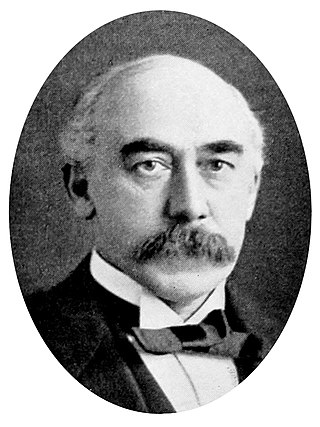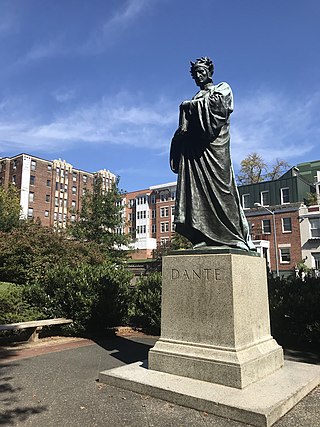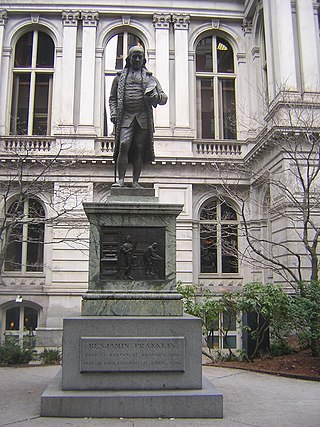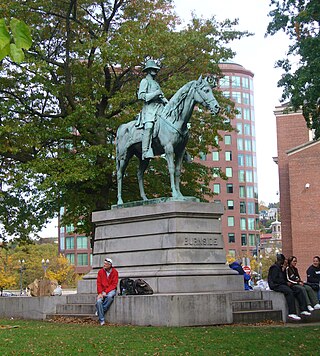
Thomas Ball was an American sculptor and musician. His work has had a marked influence on monumental art in the United States, especially in New England.
Edmund Quincy IV was a prominent Boston merchant during much of the 18th century.

Moses King was an editor and publisher who produced guidebooks to travel destinations in the United States, including Massachusetts and New York.

Samuel Lancaster Gerry (1813–1891) was an artist in 19th-century Boston, Massachusetts. He painted portraits and also landscapes of the White Mountains and other locales in New England. He was affiliated with the New England Art Union, and the Boston Artists' Association. In 1857 he co-founded the Boston Art Club.

Dante Alighieri, is a public artwork by Italian artist Ettore Ximenes, located at Meridian Hill Park in Washington, D.C., United States. Dante Alighieri was originally surveyed as part of the Smithsonian Institution's Save Outdoor Sculpture! survey in 1994. The monument is a tribute to Italian poet Dante Alighieri.

Major General George Henry Thomas, also known as the Thomas Circle Monument, is an equestrian sculpture in Washington, D.C. that honors Civil War general George Henry Thomas. The monument is located in the center of Thomas Circle, on the border of the downtown and Logan Circle neighborhoods. It was sculpted by John Quincy Adams Ward, best known for his work on the statue of George Washington in Wall Street, Manhattan. Attendees at the dedication in 1879 included President Rutherford B. Hayes, Generals Irvin McDowell, Philip Sheridan, and William Tecumseh Sherman, senators and thousands of soldiers.

John Harvard is an 1884 sculpture in bronze by Daniel Chester French at Harvard University in Cambridge, Massachusetts. It honors clergyman John Harvard (1607–1638), whose substantial deathbed bequest to the "schoale or Colledge" recently undertaken by the Massachusetts Bay Colony was so gratefully received that the Colony resolved "that the Colledge agreed upon formerly to bee built at Cambridg shalbee called Harvard Colledge." There being nothing to indicate what John Harvard had looked like, French took inspiration from a Harvard student collaterally descended from an early Harvard president.
Anne Whitney created two public statues of Samuel Adams. One, made in 1876, resides in the National Statuary Hall Collection in the US Capitol, Washington, D.C. The other, made in 1880, is located in front of Faneuil Hall Plaza in Boston.

A statue of Benjamin Franklin by Richard Saltonstall Greenough is installed outside Old City Hall in Boston, Massachusetts, United States. It rests on a base with plaques designed by Greenough and Thomas Ball.

An equestrian statue of George Washington by Thomas Ball is installed in Boston's Public Garden, in the U.S. state of Massachusetts.

A statue of William Lloyd Garrison by Olin Levi Warner is installed along Commonwealth Avenue, in Boston, Massachusetts, United States. It was designed in 1885, cast in 1886, installed on May 13 of that year. The bronze sculpture measures approximately 7 ft. x 4 ft. x 6 ft. 4 in., and rests on a Quincy granite pedestal designed by architect Joseph Morrill Wells that measures approximately 4 ft. 9 in. x 4 ft. x 6 ft. 4 in. The memorial was surveyed as part of the Smithsonian Institution's "Save Outdoor Sculpture!" program in 1993.

A 1953 statue of George S. Patton by James Earle Fraser is installed along Boston's Charles River Esplanade, in the U.S. state of Massachusetts.

A statue of John Glover by Martin Milmore is installed along Boston's Commonwealth Avenue Mall, in the U.S. state of Massachusetts.

A statue of long-time Boston Celtics coach Red Auerbach by Lloyd Lillie is installed outside Quincy Market at Faneuil Hall, in Boston, Massachusetts, United States.

A statue of John Winthrop by Richard Saltonstall Greenough is installed outside Boston's First Church, in the U.S. state of Massachusetts.

A statue of American Revolutionary War hero William Prescott by William Wetmore Story is installed next to the Bunker Hill Monument in Charlestown, Boston, Massachusetts, United States.

The Emancipation Memorial, also known as the Freedman's Memorial or the Emancipation Group was a monument in Park Square in Boston. Designed and sculpted by Thomas Ball and erected in 1879, its sister statue is located in Lincoln Park in the Capitol Hill neighborhood of Washington, D.C. The Boston statue was taken down by the City of Boston on December 29, 2020, following a unanimous vote from the Boston Art Commission on June 30 to remove the memorial.

A statue of Rufus Choate stands in the John Adams Courthouse in Boston, Massachusetts, United States. The statue was designed by Daniel Chester French and honors Choate, a lawyer and politician from Massachusetts. It was dedicated in 1898.

General Israel Putnam is a monumental statue in Hartford, Connecticut, United States. Located in the city's Bushnell Park, the statue was designed by sculptor John Quincy Adams Ward and honors Israel Putnam, a military officer in the Continental Army during the American Revolutionary War. The statue was largely paid for by a donation from judge Joseph P. Allyn and was dedicated in a large ceremony in 1874. It was one of the first statues to be erected in the park, which nowadays houses several other monuments to famous Connecticut residents. From an artistic standpoint, the statue has received mixed reviews from critics.

Major General Ambrose E. Burnside, also known as the Ambrose Burnside Monument, is a monumental equestrian statue in Providence, Rhode Island, United States. The statue, located in the city's Burnside Park, was designed by sculptor Launt Thompson and depicts Ambrose Burnside, an officer in the Union Army during the American Civil War who later served as the governor of Rhode Island. Ambrose had died in 1881 and the project to erect a statue in his honor began shortly afterwards. It was dedicated on July 4, 1887 in a large ceremony that included several notable guests of honor, such as General William Tecumseh Sherman, Colonel Robert Hale Ives Goddard, and the governors of both Connecticut and Rhode Island. The monument was originally located in Exchange Place, but it was moved to its current location in the early 1900s. As part of the move, the pedestal was replaced with one designed by William R. Walker.


















